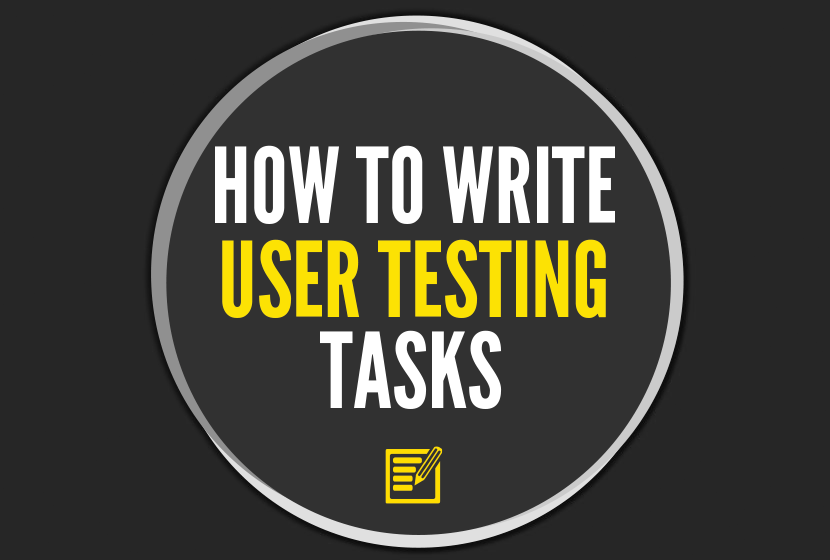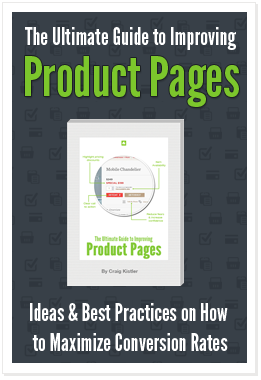There is no better time then right now to start improving your eCommerce site. One of the most effective ways to improve your site is with user testing. It is one of the best ways to identify A/B testing ideas and improve your conversion rates.
The key to these tests come down to how well you write your user testing tasks.
What is Your Testing Objective?
What do I hope to learn? This question is critical to answer before starting any user testing project. By answering this question you’ll be able to clearly identify your goals and have a head start on how you’ll use the results.
How to Structure Your User Testing Tasks
The way a task is structured is important. A well-structured task allows for you to get better feedback from the participants because it works with their natural flow through your website.
Bad example:
Create an account | Find an item to buy | Search the site | Checkout | Evaluate the home page
- This user testing task is disjointed and all over the place. The participant would never go through your website like this.
Good example:
Evaluate the home page | Search the site | Find an item to buy | Create an account | Checkout |
- This user testing task is a natural flow for the participant. It is very possible for somebody to go through your site this way.
Well Written Tasks
A well-written user testing task will produce better results than a sloppy, rambling task. It is better to keep your tasks short and concise.
Don’t write a single task that reads like:
Find a diamond necklace for around $1,275 that is at least 1 total carat weight. Add it to your cart and include the protection plan to your purchase. Then find a pair of earring that will match. Add them to your cart. Checkout.
Instead the one task should be written into multiple tasks:
- Find a diamond necklace for around $1,275 that is at least 1 total carat weight.
- Add it to your cart.
- Add the protection plan to your purchase.
- Next find a pair of earring that will match (price is up to you).
- Add them to your cart.
- Checkout.
Don’t Test the Participants
Remember, you are not testing the participants. Your tasks and follow up questions should not make them feel that way. The best way to avoid this is to make sure all blame and failures are placed on the website being tested.
How can you easily do this? Here’s an example:
Bad:
I wasn’t able to find the product I was asked to find. Agree/Disagree
Good:
The navigation made it difficult to find the product I was asked to find. Agree/Disagree
Don’t Lead, Follow.
Participants will look for the easiest path to follow—hey, they’re human, we’d all do the same thing. To combat this make sure your tasks and questions eliminate any bias or leading prompts.
For example if you were testing the checkout flow of your eCommerce site avoid saying something like: “Was it easy to checkout?” or “How much better was the new checkout?” Instead, stay neutral and try “Describe your experience while checking out.” or “Compare the new checkout flow to the original. Which do you prefer? Why?”
User Testing Task Ideas By Type
Home Page Tasks
Asking for visitors impressions of your homepage is important because they often judge a whole website just by the homepage (often in a matter of seconds), and it can help create some great test ideas.
- When possible run a 5 Second Test.
- Ask them what part of the page they noticed first. This will make sure their aren’t being drawn to something that has limited importance.
- Ask them what they would click on first. Make sure this is something you would be expecting. If not, it may be worth evaluation if the item that was clicked on is necessary.
- Ask what benefits your website offers. If they can’t clearly describe you may not to work on improving your value proposition.
Forms & Flows
The forms and checkout flows on your eCommerce website often have critical influence over your conversion rate.
Try starting with these tasks:
- Ask participants if they experienced any challenges when filling out the form. Some things to keep an eye out for are confusing layout, length of form, too many personal questions, etc.
- Do participants understand what you are asking them to complete?
- Are the error messages helpful if they made a mistake?
Navigation
- Do participants understand the options and wording in your menus?
- Ask whether they think the menus are easy to interact with.
- Ask them whether they feel the navigation helps them find the appropriate products.
Follow Up Questions
At the end of each user test you create ask participants additional questions. These are key for gaining great insights for better A/B test ideas. Here are some tips to get the most out of them:
- Always ask what other competitor websites they like to use and what features they like on them.
- Ask them what was the most frustrating thing about the website was.
- Include an open ended question that asks them to include anything else that may not have been covered by your tasks.
User Testing Task Ideas
Task: Go through the checkout process as far as you can without actually purchasing.
Question: Was anything difficult or frustrating about this process? What?
Broad Task: Find a {piece of jewelry} that you would like to buy for {yourself}. Share your thoughts out loud as you go.
- Broad tasks are good for brand, layout and content
- Allows for observing of natural behaviors
- ‘Explore type’ user testing tasks
Specific Tasks: You’re shopping for a gift. You don’t have time to have the gift shipped so you need to pick it up in a store near you. Search for an item. Review the results.
- Used to pinpoint specific areas of potential confusion.
- Targets feedback on a tool or feature the participant may not have found on his or her own.
Don’t just run user tests on your website once and move on. I run ongoing tests monthly to continually look for improvements as well as to generate A/B testing ideas.
7 Key User Testing Takeaways
- Clearly identify your goals—answer the question ‘What do I hope to learn?’
- Structure user testing tasks in a natural order. Eliminate the bouncing around – follow a linear path.
- Craft a well-written task. Use plain English, avoid jargon and be concise.
- Don’t overwhelm the participant. Create more but smaller tasks instead of fewer, larger tasks.
- Don’t lead participants where to go, follow along. This tactic avoids any bias in the results.
- Ask insightful follow up questions to gain additional insight into why the participant did what they did.
- Don’t run only one user test and call it day. Continually look for user tests that will help you learn more about your eCommerce site.
So there it is, a quick how to on writing user testing tasks with real life user testing examples.
With your objective defined, well-written and correctly planned tasks you’re on the right path to an effective user test.
Make user testing a standard part of your marketing initiatives. The insights and results you gain will be incredibly valuable to your eCommerce website.


